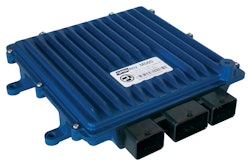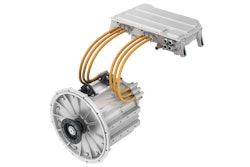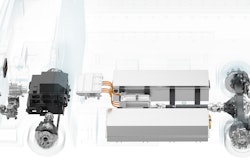
responses submitted by Marcus King, Manager of Dana China and Vice President of Dana’s Off-Highway Global Sales, Business Development, Strategy, and Program Management, Dana Incorporated
Global Markets, Government & Trade
What are the key global markets your company sees as growth opportunities and why?
For Dana, the largest growth opportunity is in Asia, especially China, India, and the southern Asia-Pacific region. The growth in China stems from the continued investment in domestic infrastructure and other construction projects, as well as the ongoing support for the Belt and Road initiative. In India, Prime Minster Modi recently committed nearly $1.5 trillion to 7,000 projects under the National Infrastructure Pipeline initiative, which will support high-speed rail, airport modernization, and advanced freight capabilities.
To take advantage of these opportunities, we have made major investments in engineering and manufacturing resources in both China and India over the past few years. In China, we’re ramping up manufacturing at a new 172,000 sq.-ft. facility in Yancheng that produces highly specialized hub drives, planetary drives, helical and bevel helical gearboxes, and hydrostatic solutions for off-highway customers in the region. This follows our addition of extensive local production capabilities last year for e-Axles, e-Hub drives, electric motors, inverters, and planetary gearboxes for e-Drives.
Meanwhile, we will be adding the production of low- to high-voltage electric motors, inverters, and vehicle control units in India that will enable us to deliver complete and fully integrated e-Propulsion systems to OEM customers across all mobility markets in the region.
With respect to end markets, we’re focusing on compact construction equipment and mobile elevated work platforms (MEWPs) to support urban projects in Europe and, to a lesser extent, in China.
We’re also seeing growth in the agriculture and material handling segments, which can be partially attributed to reactions to COVID-19. Governments are investing in agriculture capabilities as they look to preserve and reinforce food supply chains, while the exponential growth of online shopping has spurred increased sales of forklifts and other material-handling equipment.
How, if at all, has or will the passage and implementation of the United States-Mexico-Canada Agreement (USMCA) benefit your company and/or the off-road equipment industry as a whole?
The United States-Mexico-Canada Agreement (USMCA) benefits Dana as well as the entire off-road equipment industry by modernizing the 25-year-old NAFTA (North American Free Trade Agreement) and providing business stability. Dana relies heavily on a regionally integrated supply chain, and we believe this will further reduce the chance for disruptions and allow North American production to remain competitive globally. It’s essential to have a unified bed of agreements that enables us to plan the allocation of resources effectively.
Are there other policies you are keeping your eye on that could impact (or have already impacted) your company and the industry?
We’re always actively monitoring government regulations in the markets where our drive and motion systems are used to determine how we can best allocate resources to support our vehicle manufacturer customers. We have an extensive global footprint that positions engineering and manufacturing resources near our customers, and our modular approach to system design and production helps us to bring value to customers quickly as policies change.
How would passage of an infrastructure or other similar bill in the U.S.—or the equivalent in other countries—benefit the industry?
We would welcome an infrastructure bill as it would be beneficial for the off-highway industry as a whole. It also provides an opportunity to focus on sustainable energy initiatives, including expanding the charging infrastructure, which is important to expanding the adoption of electric vehicles.
Impacts of COVID-19
What have been some of the biggest challenges your company, and the industry as a whole, has faced due to the COVID-19 pandemic?
We have a strong people culture at Dana, and while we have always actively promoted a culture of safety for our team members, we have implemented additional protocols encompassing facility access, temperature monitoring, face coverings, and social distancing that have enabled our employees to return to work safely wherever they are in the world.
Also, our success as a Tier-One supplier is directly related to demand from our vehicle manufacturer customers, so we were also impacted by slowdowns and interruptions in their final assembly operations, which have now started to return. On the other hand, many of our operations were deemed essential, as they provide components for emergency and delivery vehicles that were critical to responding to the crisis.
How has your company worked to overcome these challenges?
Frequent, detailed communication has been the key to our success in addressing the business challenges presented by COVID-19. This has included internal communications with our team members as well as external communications with our customers, suppliers, and other stakeholders. Through this communication, we’ve been able to keep our priorities in line with our customers’ needs.
Our global footprint has also been a tremendous benefit. We’ve been able to leverage our global capabilities to source products from alternate facilities, and we have shared best practices from restarting our facilities in China and Italy with other parts of the world.
Additionally, we’ve gone above and beyond local government regulations to address employee safety. We’ve continually communicated our elevated protocols to assure our employees that we could get them back to work safely and restart operations.
From an engineering standpoint, we already have extensive collaboration tools in place that enable us to share engineering responsibilities across our global network of technical centers and make sure our programs keep moving forward.
Have the challenges brought to light any potential opportunities for change or improvement within your company, or the industry?
More than anything else, COVID-19 has reinforced the wisdom of our business model to position engineering and manufacturing resources within each region to serve our customers’ local operations. Our in-region supply chains, built-in redundancies, and universal quality standards have worked to our advantage.
What, if any, long-lasting effects do you think the pandemic could have on the industry?
From a long-term standpoint, many experts believe there will be continued consolidation in the industry, both in the supplier space as well as among equipment manufacturers.
How do you foresee the industry coming through this?
We expect that the long-term prospects for the off-highway industry will not change. With respect to our operations, we anticipate that some social distancing and other employee safety practices developed as part of the COVID-19 response will likely persist in some form beyond the short term.
Diesel, Electric & Other Power Alternatives
What opportunities for technology and efficiency advancements still exist with diesel engines?
The off-highway industry and the vehicle architectures within it are so diverse that we expect diesel engines will continue to be used in many applications for the foreseeable future.
While we have made considerable investments to build out our electrification technologies and expertise in recent years, we have also continued to invest in drive and motion capabilities that improve the efficiency and performance of internal-combustion engine vehicle architectures. For instance, we have recently reached agreements with three new customers to adopt our highly efficient hydromechanical variable transmission in their vehicle architectures.
Additionally, we now offer hybridization technologies that fit with current engine vehicle architectures and may offer the potential for engine downsizing. For example, the Dana TM4 IPM On-Engine Generator offers new vehicle architecture capabilities for off-highway hybrid applications where space constraints previously impeded hybridization or engine downsizing. Currently available for field testing, it offers improvements over competing technologies with respect to overall performance, physical packaging size, features, and flexibility.
The on-engine generator weighs up to 70% less than competing generators that use traditional motor construction methodologies, and it is suitable for applications including telehandlers and other small- to mid-sized off-highway vehicles with traditional engines.
How does your company see alternative fuels playing a role in the heavy equipment industry in the coming years?
At Dana, we’re energy-source agnostic. For example, while hydrogen fuel cells may play a role in the future, we have the technologies in our portfolio today and under development for the future that can take energy – wherever it comes from – and convert it through the drive and motion circuits to get the job done.
What role is electrification—or other alternative energy/power systems—playing in your company’s design initiatives?
Electrification is a key element of our corporate strategy, and Dana has made 13 acquisitions in the past 5 years – including eight focused on electrification – to strengthen our technology portfolio and engineering expertise in electrification across all the vehicle markets we serve: light-vehicle, commercial-vehicle, and off-highway.
Through these additions, we’ve been able to address immediate opportunities where the electrification of equipment is well underway, such as underground mining vehicles and mobile elevated work platforms.
For other applications where the market is developing, such as telehandlers and compact construction equipment, we are prepared with a strong array of technologies that allow us to be dynamic and responsive depending on the direction each OEM wishes to go.
Another key in the success of our electrification strategy to date has been the focus on integration. While technologies are critical, it’s equally important to understand how they work together and what adjustments need to be made to optimize performance. It’s why we acquired Nordresa and Rational Motion, both prominent integration and application engineering experts for the development and commercialization of electric powertrains. We’ve also aligned with Hyliion in the commercial vehicle space.
We have a number of small and large customers coming to us to take their traditional engine-powered vehicles and help convert them into electrified versions, and we have the internal expertise to deliver turnkey solutions that don’t require deep commitments of engineering resources on the part of OEMs.
Finally, our investments in electrification and hybridization can be applied across all mobility markets, which means we can leverage technology advancements and production volumes in the light- and commercial-vehicle markets to bring cost-effective solutions to our off-highway customers.
Are there any emissions or other related regulations your company is monitoring, or feel will have an impact on design efforts and the industry?
While there may be a pause on the implementation of emissions regulations in some geographies due to drastically decreased sales volumes in the first half of this year, we don’t anticipate significant changes in the medium and long term. City regions such as Paris are still moving forward with emissions-free initiatives, and we’re positioned to provide OEMs with the innovations they need to address them.
READ MORE: State of the Industry 2020
Data, IoT & Connectivity
How will the role of the Internet of Things (IoT) and data continue to progress in the coming years?
Data is already playing a key role in vehicle performance improvements, and its influence will continue to grow in the coming years. We’re already active in developing technologies that harvest data from our drive systems and feed into vehicle intelligence systems to improve load management, steering efficiency, and brake performance, among other aspects of performance.
We’re seeing a lot of interest from OEMs in our data collection and analysis capabilities. Our Spicer Smart Suite Intelligent Load Monitoring System (ILMS) uses patented and proprietary data-collecting technologies across the vehicle to alert the operator of potential tipping situations, reduce the risk of vehicle breakdowns, improve productivity, and enhance the long-term serviceability of drive systems.
Do you see a path toward the use of artificial intelligence, virtual reality or augmented reality in your manufacturing processes, or even on-board the vehicle itself?
Artificial intelligence (AI) will certainly play a role in autonomous vehicle operation, which is already gaining a foothold in underground mining, ports, and warehouse applications. This technology raises expectations of the performance of our components, and in the absence of an on-vehicle operator, it places a premium on the data we can harvest so vehicle intelligence systems can make sure our components are functioning optimally.
How do you see connectivity and machine learning changing the vehicle landscape in the next decade?
Dana’s next generation of shifting solutions currently use learning algorithms to evaluate how a vehicle is being operated to help make the ride more refined and efficient, while telematics will be used to communicate the performance of our components to vehicle management systems.
What challenges remain or lay ahead for the continued adoption of data, IoT and connectivity related technologies or systems?
Data and vehicle connectivity are aspects of vehicle performance that are managed by OEMs, so the role we play is in enabling our products to feed into these systems. To do so, we need to understand how vehicles ultimately use the data we provide, which is one of the reasons we developed our own electrified demonstrator vehicles.
We adapted a mid-sized aerial work platform and a mini excavator with our technologies to better understand how we can enhance the productivity, mobility, and efficiency of electric-powered vehicles. While we gained valuable technical insight that has helped us optimize our portfolio, we’ve also learned which data are most valuable to OEMs in monitoring and improving performance.
Challenges & Opportunities
What are the biggest challenges facing the industry currently, or do you see the industry facing in the coming years?
The off-highway industry is moving faster than ever before, and we constantly need to be cognizant of trends at the local level, which drives a certain degree of customization from market to market. This is driving us toward modular solutions with technologies that can be leveraged across designs while allowing for the sub-segmenting that customers expect. This approach has the added advantage of reducing our design times and improving our speed to market.
What are some of the biggest opportunities you see in the industry?
Electrification and hybridization currently offer the greatest opportunities for Dana in the short and long term. This is why we’ve made considerable investments in technologies and expertise to position ourselves to offer modular Spicer Electrified drivetrain solutions that accommodate today’s vehicle architectures. At the same time, we’re also engaged in development activities that support future vehicle designs, which will feature fully integrated electric-drive technologies in a single, optimized package.
Also, as some vehicle manufacturers reduce their investments in engineering, we have an opportunity to step forward and assume these responsibilities, which better positions us to supply complete system solutions.
Finally, we enjoy an advantage by supplying solutions to the light-vehicle, commercial-vehicle, and off-highway markets. This not only provides economies of scale for certain systems and improves our speed to market, but it also widens our perspective and positions us to think creatively about solutions.
Are there any technologies or trends which you are currently excited about in the heavy-duty vehicle industry, or most looking forward to seeing in the coming years?
Electrification is going to be a tremendous driver for Dana for the foreseeable future, which is why it’s at the forefront of everything we’re doing from a planning perspective. We’ve seen rapid shifts in the market toward electrification in the past 2 years, including growing demand from equipment buyers.



















